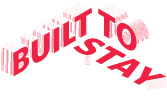Podcast Transcript
Ep. 2 James Munnerlyn
Bart: James thanks so much for joining us. We’re super excited to have you here.
James: Thank you. It’s good to be here.
Bart: So as you know, Built to Stay is all about creating businesses with staying power, something that will outlast the competition and succeed over time. James, you’ve built multiple successful businesses including Blip, and I’m wondering how you define success in business.
James: Well, I think success is something that each person defines separately for themselves. I know for me the bar for success when I was younger was very straightforward. I just wanted to work for myself.
I went and tried a number of you know things that might sound silly now, you know, very simple ventures and if I could collect my income by doing something on my own as opposed to working for someone else, that was a success. As time has gone on, as I’ve interacted with a number of businesses and that as I’ve started a couple of them, that definition has changed for me.
I’ve got kind of a new base definition of what I would consider to be success in a business and that is if you can manage to introduce a sustainable, new value exchange that results in a net improvement to all of the parties involved. And so if I break that down a little bit what I mean by value exchange is that you as a business get something but you also are giving something to someone else and I want that value exchange to be an improvement for both your business, but also the people that you’re working with.
A lot of times I see businesses that get started and that value exchanges either temporary or it’s really not a genuine improvement in the ecosystem. So at a base level, that’s how I look at success, you know for me personally. There are other things that I consider to be kind of extra bonuses when I think about success for me in a venture.
I think any company that adds new value to both sides of a transaction and it’s sustainable is fantastic, but there are other aspirational things that I strive for and I don’t get them in every business I start but I really like it when someone creates something new entirely new. There are lots of great businesses take advantage of the existing environment, but it’s so cool when someone brings something entirely new to a marketplace.
Bart: This is a really interesting concept and I want to try to break it down. Also from an example perspective, like what kind of company extracts value but doesn’t bring value to the table?
James: Man, there are some industries, I don’t know if I want to poke at them too badly, but sometimes companies, they’re still adding some measure of value but they’re not really bringing new financial value to a system. One of the things that we saw as we started Blip was that there were a bunch of companies that were trying to do something kind of similar where they were trying to essentially get a bunch of billboards and list them all in one place and then insert themselves in the middle of a transaction that would probably occur anyway between a billboard owner and a potential advertiser. So they weren’t bringing really new advertisers to the table. They were just aggregating existing inventory on one system and taking a slice of an existing pie and that may be valuable in some ways but it sure is more attractive when you can bring new value to the table.
Bart: Yeah, that’s a really good point and I think with Blip, the value that Blip is bringing is from pulling in a bunch of users who have never even considered using this or tapping into this industry before. A lot of advertisers who are advertising in one way or another but who have never had the opportunity to advertise on Billboard. So what you’re saying is to the industry, this is all a creative, it’s all extra value, its new value and that’s an exciting thing.
James: Yeah, and I don’t want to bash on companies that find themselves taking a piece of an existing pie if they’re adding some new value somewhere, but you know the world seems to work toward your benefit when you find a way to bring new dollars to the table.
Bart: Let’s talk for a minute about short-term versus long-term success. Is that useful to have in your mind a difference between short-term and long-term with failure? We decided in the last episode that you know, it’s really useful to make that delineation to say in the short term, it’s okay to fail and in fact, you know failing fast helps you to quickly get to what you’re supposed to be doing, the things that bring value, the things that bring success. But in the long-term, failures bad because ultimately we’re trying to build things either that last or in the long term, we’re successful not failures.
James: Yeah. I think it’s definitely interesting to look at short-term success versus long-term success. Some business models are inherently more prone to short-term or long-term success. But what’s most interesting to me are the business decisions themselves that lend themselves to short-term versus long-term success and I think every business makes these decisions day in and day out.
And there seems to be a connection between the degree to which you create new value as we were talking about before and the term of your success and what I mean by that is if you are focused on creating long-term value in the market that you are functioning in, you’re likely to be long-term successful. If you’re focused on extracting something right now quickly today, I think you’re less likely to have a long-term, viable business. There are other things that are clues as you look at companies as to whether or not they’re making decisions that lead to short-term or long-term success. Some examples would be companies that are product or customer focused. Those tend to correlate with long-term success companies. Whereas on the other hand, companies that seem really focused on the dollar today and they forget their customer and they don’t focus on creating and improving a quality product, they seem to be looking for short-term dollars. And those are not the companies that stick around, they’re not the companies that we all fall in love with and become an integral part of our lives.
Another way that I like to look at short-term versus long-term decisions is whether you’re focused on extracting value and getting everything you can right now or whether you’re willing to give something up and take more of an abundance mindset into the business relationships you create and your interactions with customers. And if you’re willing to give something up today, a lot of times what that means is that you’re aiming for a better overall outcome, and I think that leads to more successful partnerships and relationships and long-term success in the company. You know focusing on short term or long long-term success in the company. And so that’s where I like to focus my attention.
Bart: So with Blip, has it always been easy to make that decision to choose the long-term focus things or is that even the right way to do it?
James: I don’t know that I could say it’s always easy. But what I could say is that you always have to be focused on it. With Blip and with every company there are opportunities that present themselves and honestly, the more successful you are the more opportunities do present themselves. And a lot of times it’s very tempting to go after what looks like fast cash or you know, and abandoning something else.
A lot of times, having a long-term focus means staying focused on you know, the core thing you’re doing there. There are case studies all over the place of companies that have sort of abandoned their core brand or their core customer or their core value add just to try to chase something new and shiny and a lot of times that new shiny thing equals cash right now. But often that new shiny thing is a dangerous thing for your long-term success.
A good example of that is really early on with Blip, we recognized that we were changing the economics of billboard ownership for our partners. They used to operate at a certain level of profitability and when they joined up with us, you know, we were introducing huge amounts of new advertisers they had never had access to before. The advertisers were happy, it was the first time they could use broadcast branding on a limited budget, and the media owners were now operating at far higher levels of profitability than ever before. We saw that wow, we know something now and we have a tool that most billboard operators don’t so we could easily go buy billboards under the existing economic model that’s out there. And to us, every time we bought a billboard, it would be a screaming deal because we would know full well that we’re going to be far more profitable operating our own billboards than most media owners out there.
So that might have looked like a short-term opportunity. That was pretty compelling. We had multiple employees or family members of employees, investors that were all like I want to go buy billboards now. But as a company, one value that was really important to us was that we keep our incentives aligned with our billboard owning partners. And therefore we didn’t want to come across as competitive to them. So we made the decision early on and we’ve always stuck to that decision that in the long-term, what’s best for our company is to have these strong partnerships in which everybody wins and we have aligned incentives. It’s a good example of one choice that we made with Blip to focus on long-term success rather than some short-term gain.
Bart: Yeah, that makes a lot of sense. I kind of want to go out and buy a billboard under the old economics as well if Blip adds value and I can turn it around. James, would you mind telling us the Blip Story? How did Blip come about, maybe the three-minute version? What is Blip and how did it come about?
James: So the three-minute version is that my partner Brent Thompson and I and some friends were out for lunch one day and having a conversation and billboards came up. And Brent asked the question, can you just buy those like you would digital online advertising like Facebook, Google? You know, put a picture up there, choose when and where it should play and take it down the next day? And, I had done some work in this space and indicated that that’s not at all how it was done. And it just seemed very intuitive as we discussed it further that just like other advertising mediums and just like other industries that had been digitized, that eventually that digital technology would allow for Billboards, just like music and videos and everything else, to be sold at the single unit, the smallest single unit that you could transact. And that when you do that, the people consuming the resource are more effective and the people selling it are ultimately able to sell more to more people.
So, you know, what Blip does is take this broadcast advertising medium of billboards that have only really been used by two percent or so of businesses historically, and makes it available to everybody on any budget without contracts. We do that by reducing the amount that you have to purchase down to the single smallest unit, which is one showing of an ad and we call that a single Blip. So 8-10 seconds of an ad showing up on a billboard. So Blip’s business model is to bring broadcast branding through Billboards to the masses.
Bart: And would you say that with Blip it was an instant success?
James: Instant success? No, I mean, I most good things are hard to come by and you have to work hard for them. I would say that with Blip it was excellent timing and timing is valuable in start-up and having the right people in the right place at the right time with the right offering can make or break a startup. We had to fight all along the way but we definitely had the right people and the right product at the right time. So when that is the case, things go pretty well.
Bart: What were some of the things that you decided early on that you would be investing in the long-term on that, you know, it was tempting to do this or that but ultimately. we’re going to focus on the product and you know, not just try to extract value from it but continue to invest in it. Or were there things that were difficult for you two to decide on, we’re going to focus on the long-term more than the short-term on this even though it may be risky and a long-term investment versus short-term gains.
James: Certainly. There are probably dozens and dozens of things, a couple that come to mind, one is, you know in this industry, there’s been interest in, using technology to help people gain access to Billboards and help billboard companies be more profitable and if you think about the different customer segments that are out there, you’ve got the people who spend a lot of money all the way on down to the people who spend very little. And it was always tempting to go after the bigger customers that have bigger budgets. It’s just faster money, you go and you get one person to come buy and the impact of that sales effort is fairly significant. Whereas, if you go and you get someone to spend $10 or $5 or a dollar a day in their advertising on billboard’s, it’s a lot of work to get that person and there’s not a whole bunch of financial gain and you really have to get huge amounts of people doing that for it to become really valuable. So it was always tempting early on to go take the shortcut and go after the big advertisers. The problem with that is that we recognized that was not adding new value to the billboard owners that we had partnered with and that it was not really adding new value to the industry at large. Whereas we knew that in the long term, if we could activate the massive numbers of small businesses that are buying digital online advertising on billboards, that was the real long-term opportunity for all of us.
So that’s one example. Another is, and I think this applies to every business, the people you hire. When your business is new and small, you know, everyone has to be opportunistic, but I think there’s a lot of damage that can be done and a lot of opportunity lost in hiring quickly or hiring the wrong people or being desperate about it.
So one area that we’ve tried to stay really focused on has been to hire the best people and sometimes that leaves you feeling, you know, short-handed or a little anxious and you have to have a balance but that’s another example of something that we’ve tried to stay focused on and occasionally. We’ve made the mistake of taking the short-term gain of quickly getting a new employee and instead of getting the right person in.
Bart: That’s a painful mistake to make but it’s also painful in the moment when you have an urgent need to wait because everyone is working more than they feel like they should or even can and you need another head but to but ultimately you want it to be the right person and have a the right culture fit and the right capabilities so that it’s a good long-term decision. That’s what you’re saying, right?
James: Yeah, absolutely.
Bart: So. James if you had to boil it down, what would be the top three things that a business needs to succeed and think about the average business out there whether you’re starting it whether you’re currently in the quote-unquote messy middle where you’re still trying to figure things out. What are the top three things someone can use as The Guiding Stars so to speak for making sure that they are building something to last, building it to stick and be successful in the long run.
James: Well, it’s a fun question. And if you speak to 10 different entrepreneurs, you’ll get 10 different answers because we all have different tools in our tool belts and if we’re holding a hammer everything looks like a nail I like how you kind of broke companies in two stages when you ask the question and for me there are things that I consider to be the most valuable in early stages and different things that are valuable in later stages of a company and there’s one thing that I think binds them all together. When I look at companies that are in a very early stage or before you start a company the things that seem to be present among a lot of successful companies are one, some level of mentorship or a good network. I think that’s especially valuable at the ideation stage of starting a company. It’s hard without quite a bit of experience or some good mentorship to find new value exchange as I mentioned earlier or good business opportunities without having some experience. So I think mentorship can help there.
Secondly, one of the skills that I think is most critical when companies are in the early stage is for that company or the involved to be able to do a good job of communicating a compelling portrayal of their vision. Call it sales, call it evangelism. I don’t know what to call it, but the companies that are able to do a good job of portraying that vision or that business model that they properly identified with a good lens, that seems especially powerful. I’ve seen a lot of people try to start companies and they’ve got a cool director, they’ve got great technology, but they just don’t have someone who can do a good job of portraying that vision to customers or Partners or investors in a way that’s compelling. So they miss opportunities.
Bart: And that’s as important for customers and partners as it is potential for investors because some people start businesses without looking for investment. They don’t plan to present their business to an investor at set. Are you saying that for customers and partners you really need to be able to sell your vision for them as well?
James: Yeah, and if you’re a technical founder as an example, but you don’t have great communication skills, you’re going to need to partner up with someone that can do a good job of that. Right? It’s especially valuable as you’re trying to get some traction
Bart: For employees too, as you’re trying to hire and another big set.
James: Yeah, that is it. I would emphasize what you just said and repeat it back. It’s when you’re at a young early stage of a company your ability to attract talent when you need it, is severely challenged. I mean, even if you have a great product, so yeah that ability to portray that vision is key.
The third thing for me when looking at a company in the early stage is for the people involved to have a propensity to take sales action. I see a lot of people try to start businesses and they spend a lot of their time doing things that are exciting or fun but not really getting involved in what I would call sales conversations.
I’m a big fan of the idea that try to sell something as quickly as you can or as soon as you can and without having it perfect just yet because there’s so much that you learn in those sales conversations. There’s so much more value to be gained in those conversations than there is to try to refine and refine everything before you have them.
Bart: So a lot of people I think can identify with that idea, theoretically, that you go and sell something maybe even before you have a product or service but have you done this? And what does it look like in reality?
James: So, I mean it looks different in every case. The idea is to engage in those conversations as quickly as you can and in some cases that means you have nothing in your hands, but an idea in other cases, it means you’ve got a drawing or a slide deck and maybe you even have a proof of concept and so there are different levels of preparedness that you need to go into those conversations.
Maybe I can best describe it by giving you an example in one of my previous companies. We were doing digital marketing work for four different clients and I was talking with a client one day and recognize that they were doing something pretty repetitive. They had an employee, you know engaging in the same thing over and over and over again, so I noticed that we talked about it. We talked about what their need was and I went back and I thought about it and we decided hey, we need to create a software that will do this for people. So I went back to that client and essentially said hey, here’s a vision for what we would do to solve this problem and described it in detail and we had this back and forth.
I didn’t show up with the product. We have this back and forth. And I said, what would it need to look like? What if it looked like this? How much would you be willing to pay for and by the time I left that conversation I already had my first client. They said yep. I will pay you and I think at the time it was $300 a month for access to that software and so I went home and I spent four weeks coding that software and I went back to that client showed up and I had a business started right it was in its infancy, but because I engaged in that sales conversation before I had a product I was able to know exactly what they needed and deliver exactly what they asked for.
And in that case, it was just one customer that you talk to and you were like, okay, this is a go. That might not be enough for every business model, right? It depends on how much investments involved. In this case, it was a number of weeks of my time and I was young and scrappy and I was able to say look if this never does anything more than $300 a month and it lasts for a while, I can call it a win at the time. It’s not the case every time that you can just go talk to one person. In fact, typically that would not be the model right you’d want to engage in several conversations.
As a recap in the earlier stages, I think it’s important to have some mentorship and our Network and recognize new value exchange and good business opportunities. Secondly, I think the ability to portray a compelling vision and third propensity to take sales action so in later stages of companies those same skills or traits are valuable, but there are other things that really seem to stand out as being important as a company matures. The quality of relationships you’re able to build so your relationship building skills both internal to a company and externally with Partners investors, etc. Those seem to be critical to success. When I see failure on either of those fronts, it seems fairly fate.
And a second would be, a company’s ability to continue to focus on generating value. That’s this customer or product focus in parallel with scaling a lot of companies seem kind of like they can do one or the other and you know in later stages of a company you have to be able to scale and still maintain that focus.
The third would be. a continual passionate pursuit of the vision. Visions can change for a company, but when a company starts there seems to be this strong vision and dedication and drive and as it becomes mechanical, I think that some Founders and some stakeholders lose that original passion and things just become diluted. So those are some of the things I look for in later stages of a company and the certainly have felt important to me personally.
As I try to bring those both together, the things you need in the earlier stages and in the later stages of a company, I would say that that word “passion” is a bit of a catch-all. If you’re passionate about what you’re doing that seems to go a long way. You can be wrong, you can have a failure, but if you’re passionate that does seem to go a long way.
Bart: Yeah, that sounds right. So James, these have been really good comments. We really appreciate you taking some time to talk to us about what it takes to be successful what it takes to build your company really to stay. If you can provide that value, and it’s a lot more than the amount of value that you’re trying to extract, that seems like a good company.
James, thanks again for taking the time to talk to us today.
James: Thank you. My pleasure, it’s been fun.
Join our email list to download the Tips for Success document.




